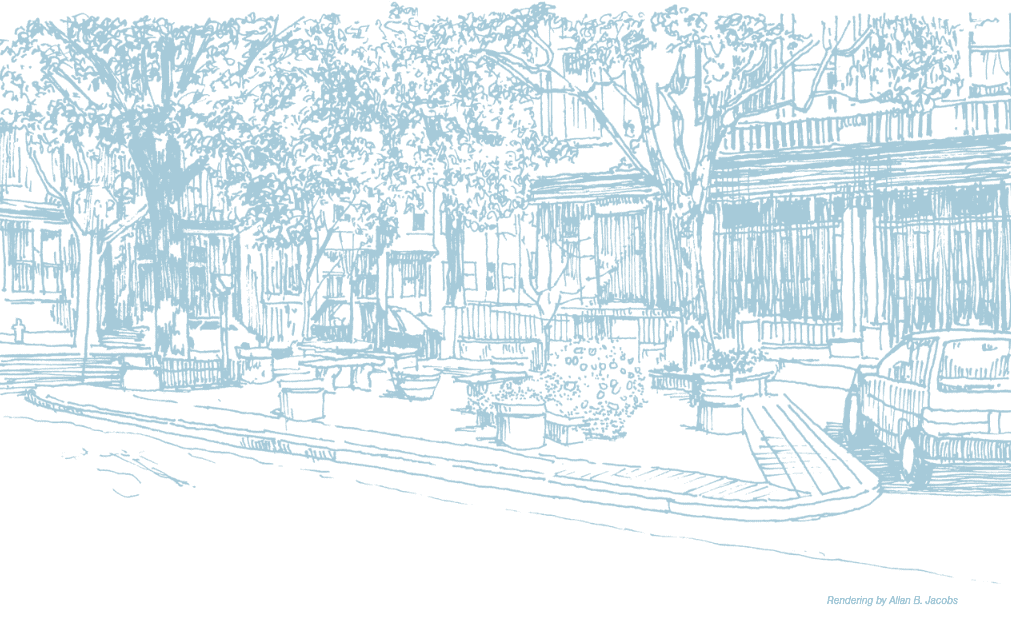Let's R3 As If People Mattered
The city is still working on the update to the R3 zoning standards. This July and August there were six community workshops, divided by neighborhood.
I was at the workshop for my neighborhood. While in attendance I felt there was a disconnect between the proposed changes, who the changes would affect, and who was present in the workshop. So I decided to investigate.
Below are my findings. I cover current conditions, the proposed changes, and the workshop attendance.
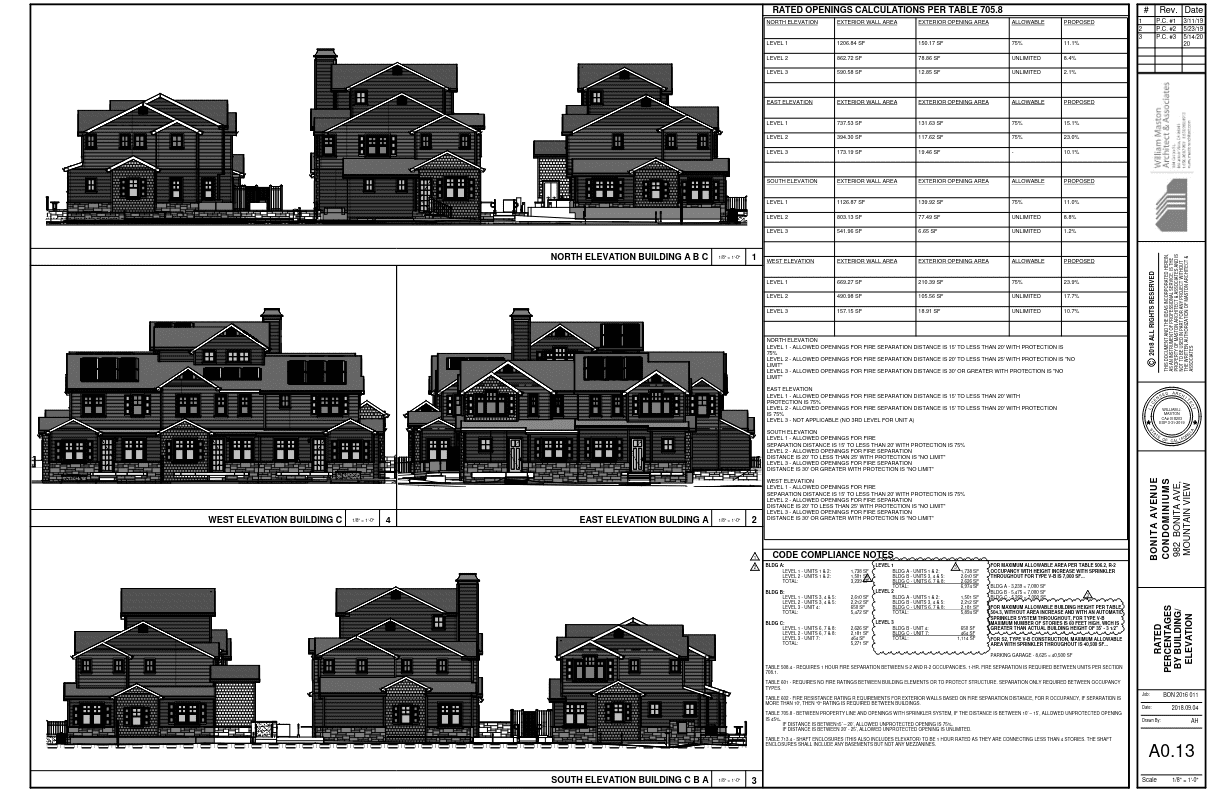
One: Current Conditions
What is R3?
R3 is Multiple Family Zoning
It is one of five residential-only zones in Mountain View. I have blogged about zoning before
In brief:
- R1 is single family. With SB-9 it now allows up to four units per lot.
- R2 is duplex. It allows everything R1 allows. It also allows duplexes. It also allows rowhouses, if the developer gets a conditional use permit.
- R3 is multifamily. It allows everything R2 allows. It also allows larger apartment buildings and condos.
R3 is not the only multifamily zoning in Mountain View:
- R4 allows higher density multifamily
- Most commercial zones allow mixed use developments which include multifamily.
- Most Precise plans (such as San Antonio, Downtown and El Camino allow mixed use and higher densities.
R3, and a few precise plans that specifically reference R3 standards, are the only affected zones.
Where is R3?
By area, about 14% of the city is zoned R3. Additionally a few precise plans incorporate some of the R3 standards by reference, and staff has informed me that updating the R3 standards could also affect these precise plan areas. Together these zones represent about 1/5 of all residential land in the city. However because R3 areas are more densely populated these areas represent about 2/5 of households in the city.
%{ include image.html url=”r3/R3_By_Neighborhood.png” alt=”R3 neighborhood map” %}
Over half of R3 area in Mountain View is between Central Expressway and 101. Between Central and El Camino, nearly all lots west of Mariposa are either R3 or precise plans. Most of the remaining R3 areas are located close to El Camino or the freeways.
Most of the development in the city is not in R3 zones. This is important to keep in mind. If someone says the multifamily zoning is too restrictive, but you see a brand-new 8-story apartment complex, you would feel they are not telling the truth. But those areas with large apartment buildings are not the areas that will be affected by the proposed changes.
Current R3 projects
There are 16 current active projects in the city that are located in R3 zones. This list includes applications under review, permitted applications, and projects under construction. R3 projects represent about 1/4 of all active projects.
| Location | Floors | Units | Type |
|---|---|---|---|
| 1332 Park Drive | 2 | 3 | Small Lot Single Family |
| 918 Rich Ave | 5 | 29 | Condo |
| 198 Easy St | 3 | 5 | Rowhouse |
| 1958 Latham St | 3 | 6 | Rowhouse |
| 828-836 Sierra Vista Ave | 3* | 20 | Rowhouse |
| 570 S Rengstorff Ave | 3 | 85 | Rowhouse |
| 1919-1933 Gamel Way | 4* | 121 | Condo |
| 294-296 Tyrella Ave | 3 | 11 | Rowhouse |
| 1057-1061 El Monte Ave | 4* | 90 | Senior Care Facility |
| 1998-2024 Montecito Ave | 3* | 17 | Condo |
| 186 E Middlefield Rd | 2 | 8 | Condo |
| 2310 Rock St | 3 | 55 | Rowhouse |
| 982 Bonita Ave | 3 | 8 | Condo |
| 410-414 Sierra Vista Ave | 3 | 14 | Rowhouse |
| 851-853 Sierra Vista Ave | 3 | 9 | Rowhouse |
| 1555 W Middlefield Rd | 3 | 115 | Rowhouse |
* - Projects using state density bonus
I marked the state density bonus projects because of some misinformation I heard repeated in the workshop.
“All the developments are using the state density bonus, so when you hear three floors you need to think of five or six”
This is not true. Only four active R3 projects are using the state density bonus, and 2 of those are not using the bonus for additional height.
Rowhouses clearly dominate active projects, accounting for approximately 2/3 of all units.
Two: Them Changes
What is changing?
While changes in height, setbacks, FAR, etc are proposed, the biggest change is the removal of the density table, which looks like this.
Note: these R3 subtypes *do not have different height standards. The building height standards are currently the same across all of R3.*
Minimum Lot Area Required (square feet) by Number of Dwelling Units
| Zone | 2 units | 3 units | 4 units | 5 units | Additional units |
| R3-1 | 7,000 | 12,000 | 14,000 | 15,000 | 1,000 per unit |
| R3-1.25 | 7,000 | 12,000 | 14,000 | 15,250 | 1,250 per unit |
| R3-1.5 | 7,000 | 12,000 | 14,000 | 15,500 | 1,500 per unit |
| R3-2 | 7,000 | 12,000 | 14,000 | 16,000 | 2,000 per unit |
| R3-2.2 | 7,000 | 12,000 | 14,200 | 16,400 | 2,200 per unit |
| R3-2.5 | 7,000 | 12,000 | 14,500 | 17,000 | 2,500 per unit |
| R3-3 | 7,000 | 12,000 | 15,000 | 18,000 | 3,000 per unit |
| R3-4 | 7,000 | 12,000 | 16,000 | 20,000 | 4,000 per unit |
| R3-D | 6,000 | 7,000 | 8,000 | 9,000 | 850 sq. ft. for each additional unit up to 30 units, and 800 sq. ft. for each additional unit for 31 or more units. |
This city is proposing replacing this chart with a form-based code.
Other changes, such as allowing local retail, or allowing additional height in exchange for public parks, are proposed as potentially being included in the update. But the core of the update is removing the dwelling unit per acre standards.
Why are the changes proposed?
Stated goals from the city’s website
- An increase in the quantity and diversity of housing (such as stacked flats)
- Opportunities for affordable housing as well as home ownership
- Neighborhoods with nearby transit, jobs and amenities that balance density with livable, green, mixed-use development
I didn’t know what stacked flats are, so I had to look it up
Also called a two-over-two or maisonette, the stacked townhouse is basically a rowhouse divided into two two-story units, one over the other. Both units have doors on the street.
A stacked flat is a rowhouse with multiple units. They are historically common, but not being built now because of current zoning.

This is a good example of what is meant by “form-based”. The code would not care how many units are inside the rowhouse, just how it looks. Height, setback, and so on would be the same regardless of the number of units.
If half of the current R3 rowhouses projects were instead two-unit stacked flats it would create 160 additional units. This would be a 30% increase in housing being built in R3, with no change in building height or setbacks.
Three: The Workshops
Who are the steak-holders?
Everyone can have opinions about building standards, but some groups will be more affected by the standards than others.
Who is listened to, and who’s needs are prioritized is a political question.
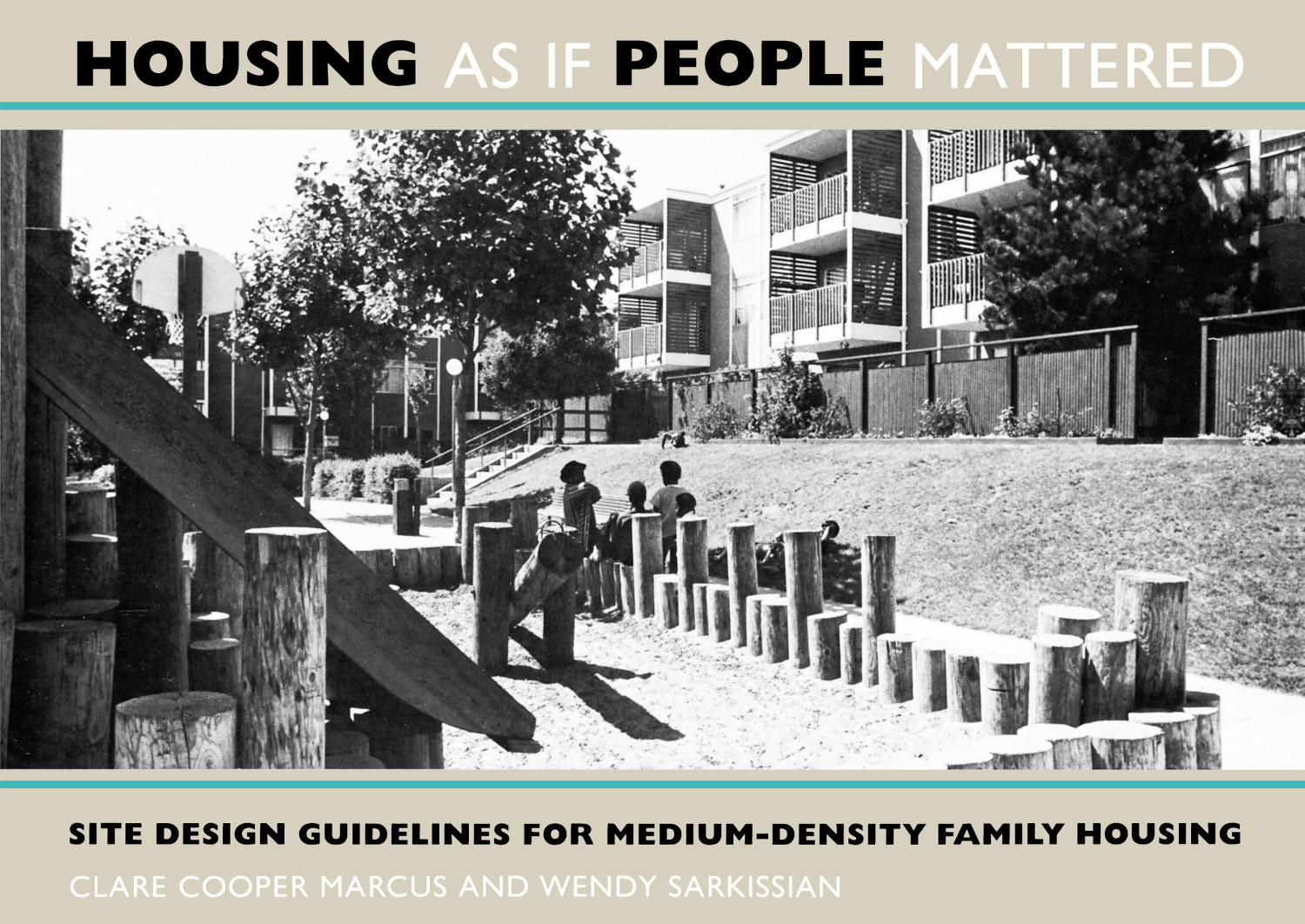
- People who currently live in R3-zoned property
- main concern: displacement
- People who currently own R3-zoned property
- main concern: value and development potential
- People who will live in new developments, developed to the new standards
- main concern: having a nice place to live
- People who will live next to new developments, developed to the new standards
- main concern: various
Who was present at the workshops?
The workshop zoom rooms had around 30-40 people in each. Around 9 of those were staff, consultants and translators.
I would love to know how many attendees were living in R3, but that question was not asked. I assume because the average person would not know if thy lived in R3 or not. Instead staffed asked attendees if they were renters or homeowners.
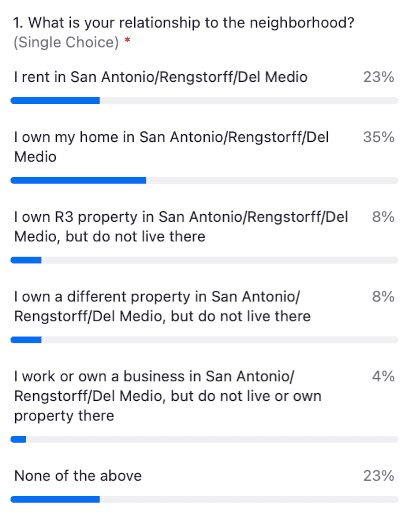

We can use census data to compare the neighborhood makeup with the workshop attendees, to see how representative the workshops were.
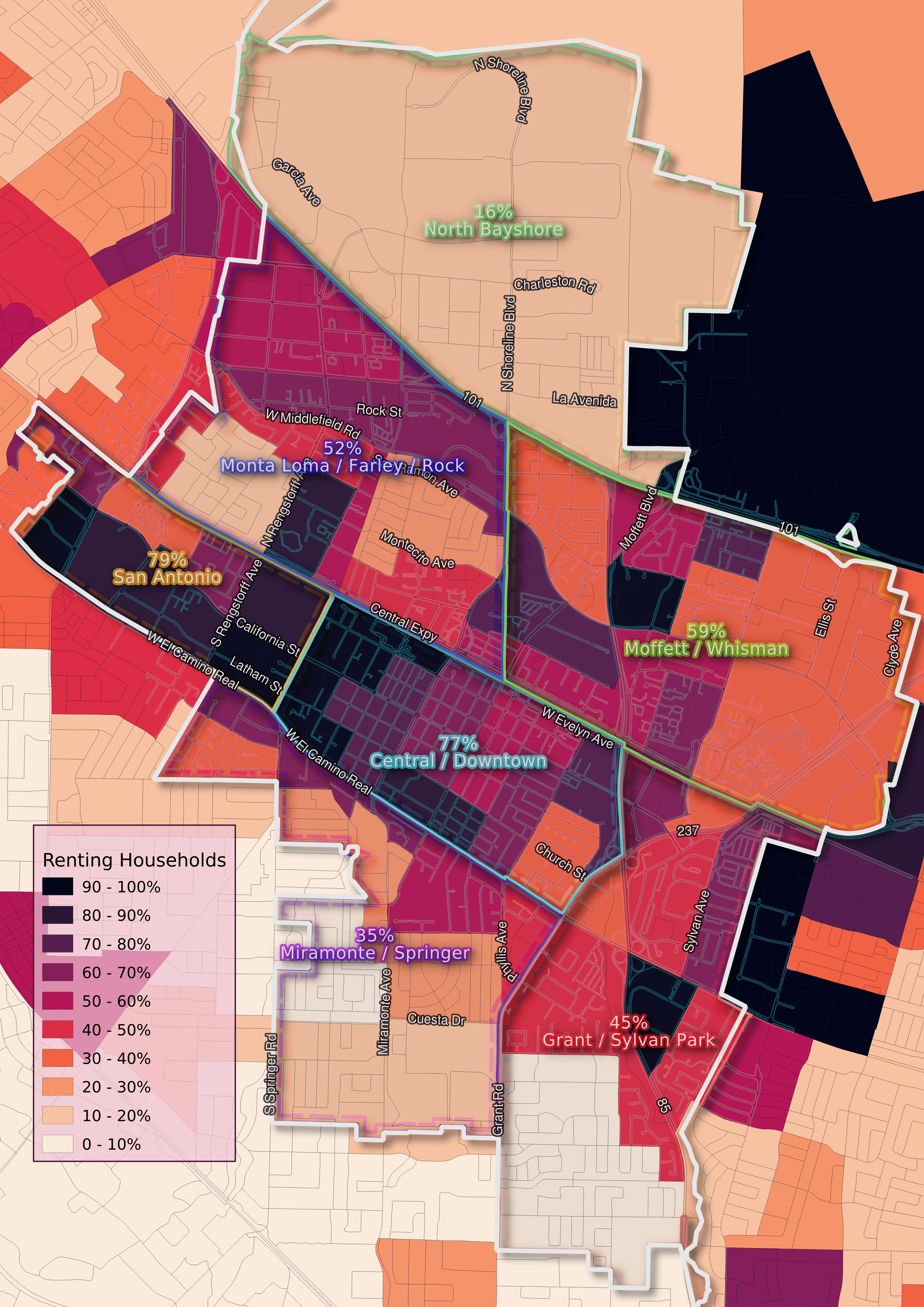
Comparing with workshop attendance is problematic, since there were also nonresidents at the workshops. I chose to scale the attendance bars such that residents equal 100%, and the nonresident portion sticks out above the 100% mark. This makes it easier to compare apples to apples in terms of renter composition.

The homeowner demographic was overrepresented in every neighborhood meeting. 4 of the 6 neighborhoods were majority renter, but in none of the workshops were the majority of attendees renters.
Since we already have the renter population data for the neighborhoods, we can estimate how many renters or homeowners each attendee represented. That is, for each renter in attendance, how many renters in that neighborhood were not in attendance?
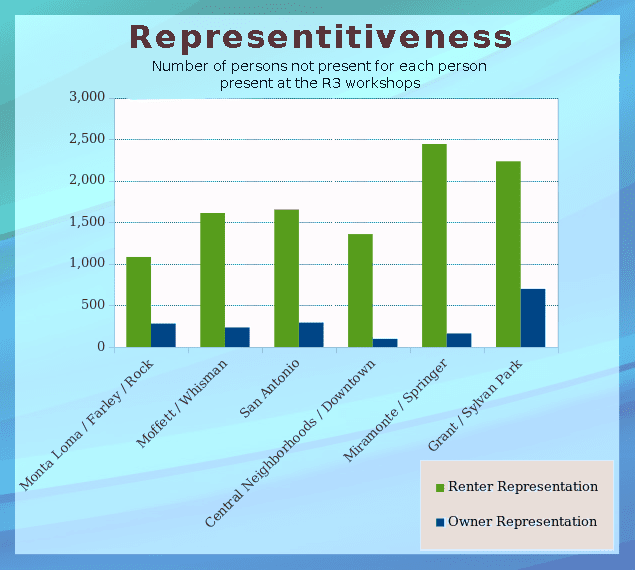
Lower bars are better. We can see renters were best represented in Farley / Rock, and homeowners were best represented in the Central Neighborhoods. The Grant / Sylvan Park neighborhood has high bars here because the workshop was poorly attended.
Conclusion
I went to the Central Neighborhoods meeting. It was long. There was talk about shadows, parking, water, schools, traffic and so on. Building height was discussed a lot. Generally the idea of increasing walkability and allowing small, neighborhood-serving retail was agreed as good. Nobody mentioned dwelling units per acre.
It was fine and good to have the discussion. Especially as there seems to be a lot of misunderstanding on what is the reality now, and what is the proposed change. I hope this post can help with the misunderstandings. Staff has said they will reach out proactively to groups underrepresented at the workshops. I hope they do so.
There is an opportunity to create much needed housing and at the same time create more walkable, sustainable and affordable neighborhoods. There are legitimate concerns, such as displacement, but I don’t want to lose sight of the goal.
